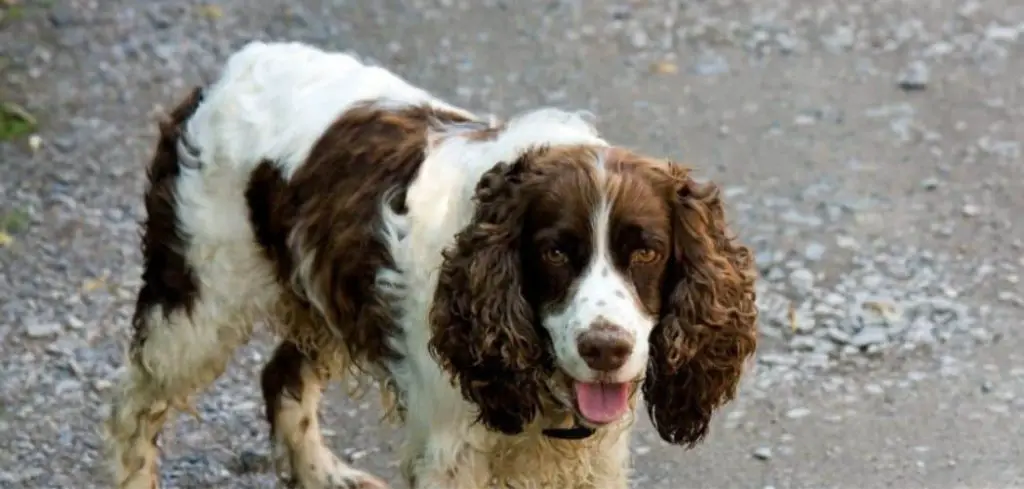Seeing your dog pass mucus and blood in their stool can be very distressing. This combination of symptoms often signals that something is seriously wrong with your dog’s health and requires close attention.
We outline the common reasons why your dog poops mucus and blood, what you can do at home, and when to seek veterinary help.
Table of Contents
Dog Pooping Mucus and Blood — Why It Happens
A dog pooping mucus and blood often points to irritation or inflammation somewhere in the gastrointestinal tract. Causes can range from dietary indiscretion and intestinal parasites to infections, colitis, or even more serious issues like parvovirus or tumors.
While some cases may be mild and resolve quickly, others can signal urgent health problems that require immediate veterinary attention.

Dog Pooping Mucus and Blood: Common Causes
Colitis
Colitis is inflammation of the colon, and it’s one of the most frequent reasons for a dog pooping mucus and blood.
Dogs with colitis often strain to defecate and may pass small amounts of soft stool streaked with red blood and coated in mucus.
This can be triggered by stress, sudden diet changes, or infections.
While sometimes temporary, chronic or severe colitis needs veterinary care to rule out underlying disease and to restore your dog’s comfort.
Read more: Dog Pooping Water and Not Eating (When to worry)
Intestinal Parasites
Worms like whipworms and hookworms can cause significant irritation to the intestinal lining. This often leads to diarrhea that may be mixed with blood and mucus.
Dogs may also lose weight, develop a dull coat, or appear lethargic if parasites are heavy. Puppies are especially vulnerable since parasites can quickly lead to dehydration and anemia.
Regular deworming and fecal exams are important to prevent this cause of blood and mucus in stool.
Dietary Indiscretion
Many dogs eat things they shouldn’t, from spoiled food to garbage.
This can irritate the gut lining, leading to inflammation and stools coated with mucus and streaks of blood.
Mild cases may resolve within a day or two, but severe digestive upset can result in dehydration, pain, and persistent bloody diarrhea. If your dog continues to strain or becomes weak, veterinary evaluation is necessary.
Parvovirus
Parvovirus is a life-threatening viral infection, especially in unvaccinated dogs and puppies. One of its hallmark signs is foul-smelling diarrhea that often contains blood and mucus.
Dogs with parvo usually appear very sick — they may vomit, refuse food, and quickly become dehydrated.
This condition requires immediate emergency care, as it can be fatal without aggressive treatment.
Inflammatory Bowel Disease (IBD)
Dogs with IBD experience chronic inflammation in the intestines. Over time, this can cause frequent bouts of diarrhea with mucus and blood.
Affected dogs may also lose weight, have poor appetite, and experience abdominal discomfort. Since IBD is a long-term condition, it requires veterinary management, including diet changes and medications, to control symptoms and prevent flare-ups.
Tumors or Polyps
Growths in the colon or rectum can also cause mucus and blood in a dog’s stool. These may be benign polyps or malignant cancers.
In addition to bloody stools, dogs may strain, pass smaller amounts of stool than normal, or show discomfort when defecating.
Early diagnosis through veterinary evaluation is essential, as some tumors can be treated successfully if caught early.
What to Do If Your Dog Is Pooping Mucus and Blood
If your dog has only passed one stool with mucus and a small streak of blood but otherwise seems normal, you may monitor them closely for 24 hours. Withhold rich treats, offer a bland diet, and ensure they have plenty of fresh water.
If symptoms persist, worsen, or are accompanied by lethargy, vomiting, or refusal to eat, your dog should be seen by a vet right away.
Never assume it will clear on its own, especially in puppies, older dogs, or dogs with existing health issues.
Keep your dog calm, limit strenuous activity, and avoid offering table scraps or unusual foods.
Collect a stool sample to bring with you, as it will help the vet identify infections or parasites more quickly.
When to Call or Visit Your Vet
You should contact your veterinarian immediately if:
Your dog passes large amounts of blood or repeated bloody stools.
The stool is black and tarry, which suggests internal bleeding.
Your dog is lethargic, vomiting, or refusing to eat or drink.
A puppy or very small dog develops bloody or mucus-filled diarrhea, as they dehydrate quickly.
Symptoms persist for more than 24–48 hours.
Since some causes, like parvovirus or poisoning, progress rapidly, timely veterinary intervention can save your dog’s life.
Read more: Dog vomiting not eating not pooping (Here’s why)
Key Takeaway
Seeing your dog pooping mucus and blood is alarming and should never be ignored.
While mild digestive irritation can cause temporary symptoms, more serious conditions like parvovirus, parasites, or colitis may be to blame.
Monitor your dog closely, provide gentle care at home if symptoms are mild, and never hesitate to call your vet if your dog seems unwell or the problem continues.
Acting quickly helps ensure your dog gets the treatment they need and stays on the path to recovery.
